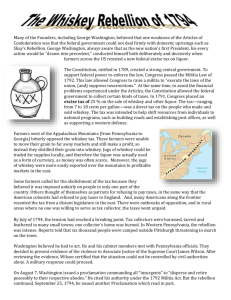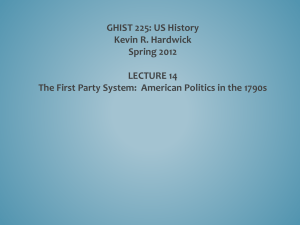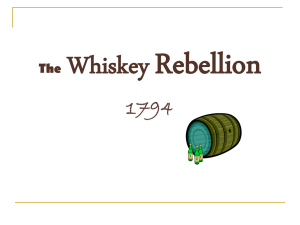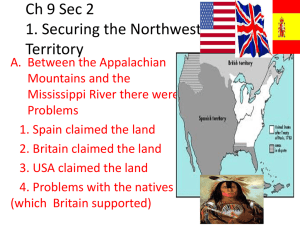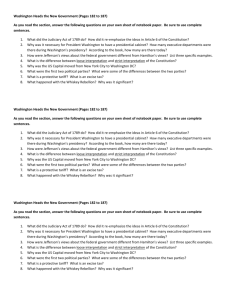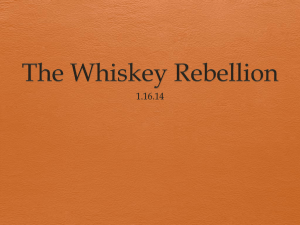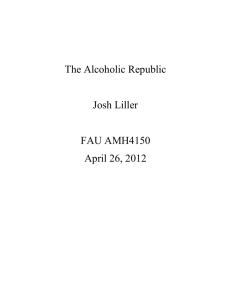THE WHISKEY FLAGS -- by Richard R. Gideon
advertisement
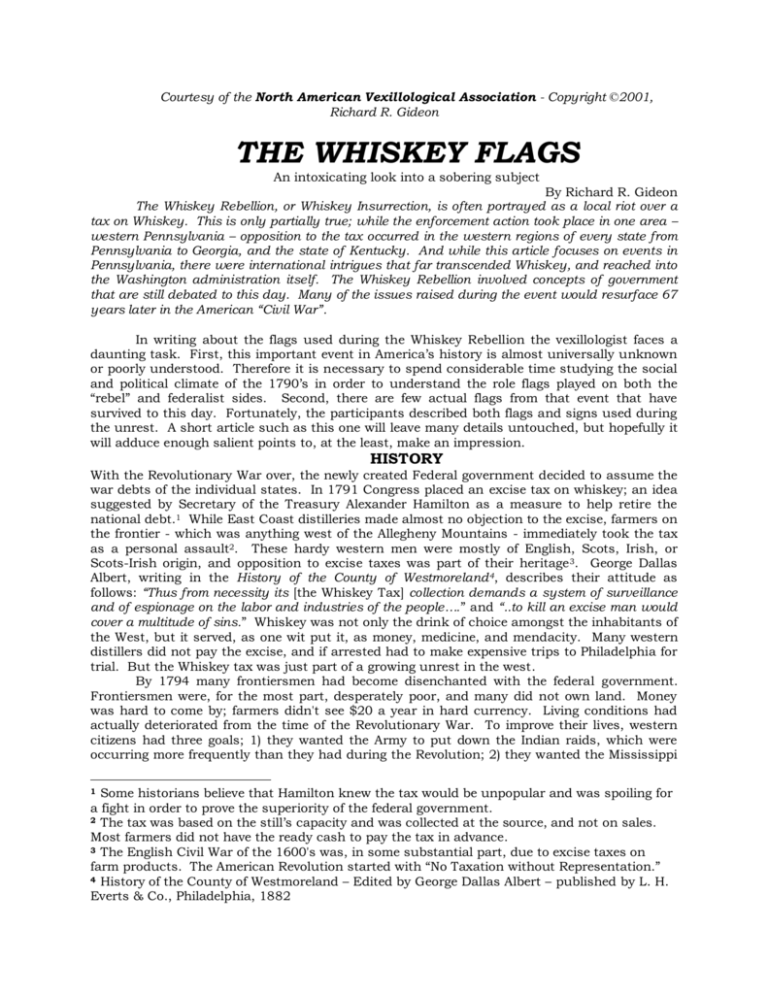
Courtesy of the North American Vexillological Association - Copyright ©2001, Richard R. Gideon THE WHISKEY FLAGS An intoxicating look into a sobering subject By Richard R. Gideon The Whiskey Rebellion, or Whiskey Insurrection, is often portrayed as a local riot over a tax on Whiskey. This is only partially true; while the enforcement action took place in one area – western Pennsylvania – opposition to the tax occurred in the western regions of every state from Pennsylvania to Georgia, and the state of Kentucky. And while this article focuses on events in Pennsylvania, there were international intrigues that far transcended Whiskey, and reached into the Washington administration itself. The Whiskey Rebellion involved concepts of government that are still debated to this day. Many of the issues raised during the event would resurface 67 years later in the American “Civil War”. In writing about the flags used during the Whiskey Rebellion the vexillologist faces a daunting task. First, this important event in America‟s history is almost universally unknown or poorly understood. Therefore it is necessary to spend considerable time studying the social and political climate of the 1790‟s in order to understand the role flags played on both the “rebel” and federalist sides. Second, there are few actual flags from that event that have survived to this day. Fortunately, the participants described both flags and signs used during the unrest. A short article such as this one will leave many details untouched, but hopefully it will adduce enough salient points to, at the least, make an impression. HISTORY With the Revolutionary War over, the newly created Federal government decided to assume the war debts of the individual states. In 1791 Congress placed an excise tax on whiskey; an idea suggested by Secretary of the Treasury Alexander Hamilton as a measure to help retire the national debt.1 While East Coast distilleries made almost no objection to the excise, farmers on the frontier - which was anything west of the Allegheny Mountains - immediately took the tax as a personal assault2. These hardy western men were mostly of English, Scots, Irish, or Scots-Irish origin, and opposition to excise taxes was part of their heritage 3. George Dallas Albert, writing in the History of the County of Westmoreland 4, describes their attitude as follows: “Thus from necessity its [the Whiskey Tax] collection demands a system of surveillance and of espionage on the labor and industries of the people….” and “..to kill an excise man would cover a multitude of sins.” Whiskey was not only the drink of choice amongst the inhabitants of the West, but it served, as one wit put it, as money, medicine, and mendacity. Many western distillers did not pay the excise, and if arrested had to make expensive trips to Philadelphia for trial. But the Whiskey tax was just part of a growing unrest in the west. By 1794 many frontiersmen had become disenchanted with the federal government. Frontiersmen were, for the most part, desperately poor, and many did not own land. Money was hard to come by; farmers didn't see $20 a year in hard currency. Living conditions had actually deteriorated from the time of the Revolutionary War. To improve their lives, western citizens had three goals; 1) they wanted the Army to put down the Indian raids, which were occurring more frequently than they had during the Revolution; 2) they wanted the Mississippi Some historians believe that Hamilton knew the tax would be unpopular and was spoiling for a fight in order to prove the superiority of the federal government. 2 The tax was based on the still‟s capacity and was collected at the source, and not on sales. Most farmers did not have the ready cash to pay the tax in advance. 3 The English Civil War of the 1600's was, in some substantial part, due to excise taxes on farm products. The American Revolution started with “No Taxation without Representation.” 4 History of the County of Westmoreland – Edited by George Dallas Albert – published by L. H. Everts & Co., Philadelphia, 1882 1 river - then controlled by Spain - opened to navigation, thus allowing western farm goods and furs to be polled down the Ohio and Mississippi to New Orleans; and 3) frontiersmen in various areas of the country wanted to incorporate into their own States. This had actually happened in western North Carolina; in 1784 the people there formed the State of Franklin, electing a governor and representatives. In western Pennsylvania the proposed State was to be called Westsylvania.5 It was this last aspect - a desire for local autonomy - that made many officials in both state and federal governments very nervous. States were not enthusiastic about giving up large portions of their territory. New territorial governments in what were now buffer zones might seek alliances with Spain or Britain. Indeed, by the time of the Whiskey Rebellion there were already reports of overtures being made to and by local leaders in western Pennsylvania and Kentucky.6 The federal government, for its part, recognized the value of western lands and the need to move produce to more commercially lucrative markets. George Washington had proposed a canal between the Monogehelia and Potomac rivers; a project he supported all his political life. But recognizing the value of western inhabitants was another matter. They were not very highly thought of by many of the officials of the new federal government, including Washington, and almost anyone else in the more civilized East. 7 The diary of a woman who made the trip into the frontier is full of frank observations about western farmers, whom she called “ignorant, drunk, dirty, blasphemous, and about as wild as the Indians.” 8 One of the favorite pastimes of western men was eye gouging, which occurred regularly during Sunday morning contests of manhood. Enter now the excise tax. And while the western farmer may not have been able to read or write, he did know an assault on liberty when he saw it. In turn he assaulted the tax collector, using such time-honored techniques as verbal and physical intimidation, tar and feathers, and selective house burnings. The propertied and educated men of the Pittsburgh region were not as pyretic as their country neighbors, but most of them were against the excise as well.9 Most, that is, except for a few acquaintances of George Washington. One of Washington's boyhood friends, John Neville, owned about 1000 acres of land along Chartiers cheek. 10 He built a large clapboard home – the country inhabitants called it a mansion – on Bower Hill, about 7 miles Southwest of Pittsburgh. Neville had been a General in the Revolutionary Army and was once popular with the locals; a man noted for his charity and opposition to the Commonwealth‟s excise tax. But when he supported Washington and became the chief excise collector he became just another rich, slave-holding aristocrat.11 Events came to a head in July of 1794 when Neville led United States Marshal David Lennox to the farm of William Miller. The marshal proposed to serve Miller with a writ to appear in Philadelphia 12 and answer charges of refusing to enroll his Whiskey still. Men The state of Westsylvania was an idea first proposed in the summer of 1776. The intrigues of frontier leaders and their foreign contacts are well documented; a recommended source is the book “The Whiskey Rebellion” by Thomas Slaughter 7 While outnumbered by farmers, it is often overlooked that there were many highly educated men living amongst the western peoples; Hugh Brackenridge and Rev. John McMillan, to name just two, were graduates of the College of New Jersey (Princeton). Albert Gallatin, a Swiss Aristocrat turned republican, lived in an even more remote area some 50 miles south of Pittsburgh. 8 “The Whiskey Rebellion” by Thomas Slaughter 9 The Commonwealth had repealed its own Whiskey excise law, with lawmakers calling it “unenforceable.” 10 Washington himself owned 70,000 acres of prime frontier land. 11 The Commonwealth had enacted a gradual emancipation (1 March 1780) which phased in freedom over a 28 year period. Although it is beyond the scope of this article, slavery had a sidebar role to play in the Whiskey Rebellion. 12 The federal government had rescinded the requirement to appear in a federal court, permitting the accused to be tried in local courts. However, for some reason writs served during the summer of 1794 still required a Philadelphia court appearance. 5 6 working in the fields got wind of what was happening, and with rifles in hand raced toward Neville and the marshal. Shots rang out, but no one was hit and the pair beat a hasty retreat. Another popular Revolutionary War hero, Captain James McFarlane, led the local militia to Neville's mansion, demanding that Neville quit his post and turn over all excise records to McFarlane. The request sparked a two-day confrontation between soldiers sent from Ft. Pitt to protect Neville. On the second day shots were exchanged and McFarlane was killed. Momentarily stunned, participants on the militia side cried foul, saying that McFarlane had been lured out into the open by what he thought was a request for a conference. Bewilderment soon turned to rage, and the Neville home, barn, & some slave quarters were burned to the ground. FLAGS Even prior to the attack at the Neville plantation protest flags had started to make their appearance. It is clear from the written evidence of the time, and from the research of many respected writers and historians, that these “rebel flags” fall into one of two categories: scripted flags and simple striped flags. According to Leyland Baldwin, “Liberty poles bearing devices such as the familiar revolutionary emblem of a snake divided, or with inscriptions such as „An Equal Tax, and No Excise‟, were being erected at many places in the Monongahela country.”13 After Neville‟s home was burned the rebels held several meeting to discuss their options. In his book, “The History of Washington County,” Boyd Crumrine describes a meeting at which was raised “..a liberty pole, from which floated a flag bearing the inscription, „Equal Taxation and no Excise – No Asylum for Traitors and Cowards.‟”14 Writing on the occasion of the bicentennial of the Rebellion, Jerry Clouse writes: “It [a liberty pole] could elevate an official flag or banner, or a home-made version, most often inscribed with the words „Equal Taxation and No Excise‟ or „Liberty and Equality.‟” 15 Published by the Commonwealth of Pennsylvania, Clouse‟s book also has an interesting comment about a rebel flag raised in Hagerstown, Maryland. Speaking of the Federal government‟s attempt to draft men to fight the “Whiskey Boys,” Clouse describes the reaction of the local militia: “Militiamen „beat their officers from the field,‟ and raised a liberty pole with a flag inscribed with the words „Liberty or Death.‟”16 Historian David C. Knight also adduces contemporary evidence concerning scripted flags, and writes, “Often they [liberty poles] bore the familiar revolutionary emblems of a snake divided, with streamers or flags bearing inscriptions such as „An Equal Tax and No Excise O Whiskey.‟”17 At one gathering the rebels raised a liberty pole with a flag featuring six bars. Hugh Henry Brackenridge, a moderate who was opposed to both the tax and the violence, specifically mentions this flag in a book he wrote about the rebellion. “At Parkinson‟s Ferry, I think it was the morning of the second day, one was raised with a flag with six stripes, emblematical of the six counties there represented.”18 Brackenridge‟s son, Hugh Marie, would write later of „stars‟ in the flag. When President Washington sent commissioners on a fact-finding trip to Pittsburgh, “A riotous and disorderly assemblage raised a liberty pole before the lodgings of the commissioners, and would have run up a flag with seven stars for the four western counties, and for Bedford and the two counties of Virginia, but this was prevented by the well disposed citizens, who prevailed on them to “Whiskey Rebels” by Leland D. Baldwin, p103 History of Washington County by Boyd Crumrine, p287 15 The Whiskey Rebellion: Southwestern Pennsylvania Frontier People test the American Constitution by Jerry Clouse, p30 16 ibid.: p34 17 The Whiskey Rebellion, 1794 by David C. Knight, p41 18 “Incidents of the Insurrection” by Hugh Henry Brackenridge, p137 13 14 substitute the flag of the fifteen States.” 19 Thomas P. Slaughter, in an exhaustive study of the post revolutionary period, speaks of „rebel flags‟ flying throughout the western Pennsylvania area. Another respected researcher, Anthony A. Martin, wrote an article about Whiskey flags for the National Flag Foundation‟s (NFF) “The STANDARD BEARER” magazine.20 Martin, Director Emeritus of the Carnegie Library of Pittsburgh, and a librarian and researcher for NFF, drew upon the some of the works sited above, plus many others. Martin writes that at one meeting the rebels unfurled a flag of “six stars and six bars” and “…yet another had 7 stars and 7 bars, representing 5 Pennsylvania counties and 2 Virginia counties.”21 What all these described flags have in common is simplicity and an anti-Federal theme. Again, if one looks at the politics and people of the region the anti-Federal theme is not surprising. The people of western Pennsylvania (and many other western regions) were NOT, for the most part, federalists. They did not support the US Constitution when it was first moved for a vote; in fact, the local Congressman, William Findley, voted against it. Even those men who were in favor of the Constitution – Hugh Henry Brackenridge for example – definitely were not in favor of a tax that favored the East at the detriment of the West, and were highly suspicious of the intentions of the Washington administration. Amongst the Whiskey Rebels were men who had fought in the American Revolution, and they took the rhetoric and symbolism of the time seriously. They were very much in favor of the French Revolution (remember, the year is 1794) and against “Eastern aristocrats.” So it makes perfect sense that the flags they would employ would reprise American Revolutionary themes. Also one must remember that most of rebels were poor (or frugal) farmers, and that highly intricate flags would probably not be within their means. So when the correspondents of the time describe rebel flags they give us a glimpse of simple patters and/or scripted fabrics that have not, unfortunately, survived to this day. The one they don‟t mention, however, is a flag that actually exists, mounted in a frame, and hanging on the wall in the bar of the Century Inn in Scenery Hill, Pennsylvania. A blue field flag of modest dimensions, it contains the device of an eagle holding a ribbon it its beak, and thirteen six-pointed stars scattered about the field. Sold in flag stores across America, this handsome and interesting flag has for years been associated with the Whiskey Rebellion. Anthony Martin says that part of the reason for this is the description of it given by Admiral William Furlong in his book “So Proudly We Hail,” published by the Smithsonian Institution. In his comments Furlong says that it is “an unusual flag, believed to be used by the Whiskey Rebels…”. 22 But Martin points out that no contemporary accounts mention this flag. In his NFF article Martin says, “Several facts support my theory that the Scenery Hill flag was, at best, a relatively minor Whiskey Rebellion flag, and most likely designed and produced post-rebellion.” 23 Martin makes several points to support his theory, but his major point - that if one assumes this flag was a rebel flag then the symbolism is wrong - cannot be easily dismissed. Remember that we are discussing a flag used by poor farmers and radicals, possessed of limited resources. The Scenery Hill flag is made of silk, with an intricate Federal pattern. Perhaps, however, there is a better explanation. The vexillologist may look at the Scenery Hill flag and wonder whether he or she hasn‟t seen it someplace before. Grace Rogers Cooper, in her monograph entitled “Thirteen-Star Flags, “History of the Western Insurrection” by Hugh M. Brackenridge, p195. It is interesting to note that the 15 star – 15 stripped US flag was not officially adopted at this time, yet Brackenridge describes it is as being flown in the Summer of 1794. 20 January-February, 1995 21 “NFF SPECIAL REPORT – THE WHISKEY REBELLION” by Anthony A. Martin, p9 22 “NFF SPECIAL REPORT – THE WHISKEY REBELLION” by Anthony A. Martin, p9 23 “NFF SPECIAL REPORT – THE WHISKEY REBELLION” by Anthony A. Martin, p10 19 Keys to Identification,” writes of the fabric used by the Army in the late 18th century. Her conclusion is that the two predominate materials were silk and wool. She also notes the use of the “eagle-and-star canton” in post-Revolutionary War flags.24 According to Cooper, the earliest use of “thirteen stars and eagle” stripped flags is 1784. Since Army regimental flags were often just blue fields with the Arms of the United States painted or embroidered upon them, could the Scenery Hill flag have some relationship to the Federal army and not the rebel one? One might argue against this theory on the basis of the flag‟s rather small size; however, there are many 18th century Army regimental flags that do not measure the customary six feet square. We must also remember that there was a substantial Federal presence in western Pennsylvania. There was a US fort in Pittsburgh, and the army did conduct several sorties against the Indians in the 1790‟s. There were also civilian Federalists living in the area, although it is highly unlikely that they would be so bold as to display a federal flag during the height of the unrest.25 Washington Responds The Whiskey Rebels had proposed to march on Pittsburgh and take Ft. Pitt, but two important things happened: First, the rebel leaders decided to put on a show a force instead of assaulting the fort; and second, the citizens of Pittsburgh passed out free Whiskey to the rebels when they arrived, and told them they were on their side. But by this time, however, Washington had had enough. He sent 12,950 26 hastily organized states‟ militia across the mountains from Carlisle, Pennsylvania and Cumberland, Maryland, to put down the rebellion. The march began in September with troops that were about as disciplined as the “Whiskey Boys”, and only half of them made it to Pittsburgh. Along the way they managed to kill two innocent people; a young boy and an intoxicated man who had the nerve to toast the success of the "Whiskey Boys" in front of a squad of soldiers. President Washington himself led the troops to Bedford, PA, then turned the army over to General Henry "Light Horse Harry" Lee, a fellow Virginian and one of Washington's favorite generals during the Revolution. 27 The whole episode turned into an anti-climax; by the time the army arrived in Pittsburgh the rebellion had burned itself out, and many of the local actors had moved on to Kentucky or other western regions. This type of law enforcement helped turn westerners toward the new DemocraticRepublican Party of Thomas Jefferson; himself distrustful of powerful central governments. However, it established once and for all the power of the new government to raise money by taxation. The Whiskey Rebellion shook the Washington Administration. Washington wrote both publicly and in his diary about the danger to order posed by the insurgents. At the time of the action in western Pennsylvania the French Revolution was in full swing, and the frontiersman identified with the French radicals. The US government would later take drastic measures to insure order in the new country, adopting the Alien and Sedition Acts. Washington had problems in his own administration over both the “Whiskey Boys” and international relations. A letter from the French Minister to his government fell into Washington‟s hands. The letter was full of critical remarks made by Secretary of State Edmund Randolph against Washington‟s handling of the Whiskey affair. Washington confronted Randolph, and the Secretary of State resigned. CONCLUSION It is the conclusion of this writer that the Whiskey Tax rebels or protestors used flags of simple patterns, probably mostly scripted or striped; that during this period the Federal army used well documented regimental type flags, featuring variations of the Arms of the United States; and that the economy of the western Pennsylvania area, and the mindset of the “Thirteen-Star Flags” by Grace Rogers Cooper, the Smithsonian Institution Press, 1973. The rebels did not cow the Rev. John McMillan, a Presbyterian minister. Although he opposed the excise tax, he would not give communion to any parishioner who did not obey the Federal law. 26 More troops than Washington commanded during the whole of the Revolutionary War. 27 Lee's son, Robert Edward, would also make a trip to Pennsylvania one day, as commander of the Army of Northern Virginia. 24 25 farmers, was such that it is unlikely that the rebels would produce a blue silk flag with Federal symbolism. And it is also clear that while the bulk of the enforcement action took place in western Pennsylvania, rebel flags could be found in other states as well. Flags used in western Virginia and western Maryland have been documented by contemporary writers, and make a tempting research subject for the vexillologist. The Whiskey Rebellion was the major event of its time, and that it is not well studied and understood is a national disgrace. That said, I will let President Washington have the last words: "This Government, the offspring of your own choice uninfluenced and unawed, adopted upon full investigation and mature deliberation, completely free in its principles, in the distribution of its powers, uniting security with energy, and containing within itself a provision for its own amendment, has a just claim to your confidence and your support. Respect for its authority, compliance with its laws, acquiescence in its measures, are duties enjoined by the fundamental maxims of true liberty. The basis of our political systems is the right of the people to make and to alter their constitutions of government. But the constitution which at any time exists till changed by an explicit and authentic act of the whole people is sacredly obligatory upon all. The very idea of the power and the right of the people to establish government presupposes the duty of every individual to obey the established government.” ......GEORGE WASHINGTON Bibliography: Albert, George Dallas: History of the County of Westmoreland. Published by L. H. Everts & Co., Philadelphia, 1882 American Historical Society, The: History of Pittsburgh - Volume 2, Published 1922 Baldwin, Leland B.: Whiskey Rebels: A Story of a Frontier Uprising. Published by the University of Pittsburgh Press, 1939 Brackenridge, Hugh Henry: Incidents of the Insurrection in the Western Parts of Pennsylvania in the Year 1794. Published by John McCulloch Philadelphia, 1795. Brackenridge, Hugh Henry: Law Miscellanies. Published by P. Byrne, Philadelphia, 1814. Brackenridge, Hugh Marie: History of the Western Insurrection – 1794. Published by W. S. Haven, Pittsburgh, 1859. Cooper, Grace Rogers: Thirteen-Star Flags, A Key to Identification. Published by the Smithsonian Institution Press, 1973. Jerry Clouse: The Whiskey Rebellion: Southwestern Pennsylvania Frontier People test the American Constitution. Published by the Commonwealth of Pennsylvania - 1994 Crumrine, Boyd: History of Washington County, PA. Published by L.H. Everts & Co., 1882 Gideon, Richard R.: Family Genealogy (Note: Some of the author‟s family members were involved in the Whiskey Rebellion) Knight, David C.: The Whiskey Rebellion, 1794 Published by Franklin Watts, Inc, 1968 Martin, Anthony A.: NFF Special Report – The Whiskey Rebellion, The Standard Bearer. Published by the National Flag Foundation Slaughter, Thomas P.: The Whiskey Rebellion. Published by Oxford University Press, 1986 The Pittsburgh Gazette: Various publications from 1791 to 1795
